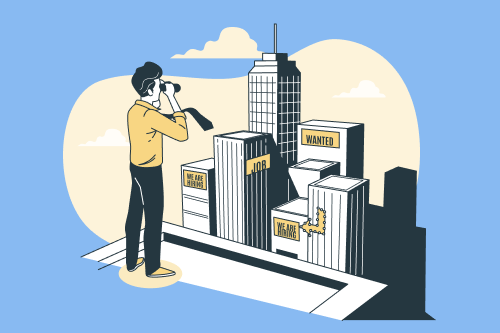- The Recruiting Life
- Posts
- Do women sexually harass men at work? Umm... Yes, yes they do.
Do women sexually harass men at work? Umm... Yes, yes they do.
#MeToo is for men too.

In this issue:
Sectorial Shift: The US Labor Market (1939 - 2021)
Do women sexually harass men at work? Umm... Yes, yes they do.
AI will make 3.5 day work weeks likely
PODCAST - Why do women bully women at work?
COMIC- If I’m being honest…
The Week in Recruiting

CHART: Sectorial Shift: The US Labor Market (1939 - 2021)
Total private nonfarm employment, by industry (in millions)

Do women sexually harass men at work? Umm... Yes, yes they do.

Are there more women in positions of corporate power than ever before? The stats say yes. According to a 2022 report by the Pew Research Center, 38% of women in the workforce are in management positions, up from 34% in 2015. This represents a significant increase, and it is likely due to a number of factors, including increased educational attainment among women, changing social norms, and corporate policies that are aimed at promoting gender diversity in the workplace. A few examples…
In the United States, women hold 47% of management positions in the private sector, up from 38% in 2019.
In the United Kingdom, women hold 35% of management positions in the private sector, up from 29% in 2019.
In Canada, women hold 29% of management positions in the private sector, up from 25% in 2019.
In Australia, women hold 40% of management positions in the private sector, up from 36% in 2019.
If women are holding more positions of power, does that mean that there is a higher possibility of them abusing their authority? Most definitely. According to the Workplace Bullying Institute’s "The 2021 WBI Workplace Bullying Survey," 11% of the men surveyed had experienced bullying at work from a female perpetrator. It is the lowest recorded of the data they studied, but it does happen.

But is that 11% an outlier or a growing trend? I think it’s indicative of a trend. Judging by EEOC data, sexual harassment of women against men has been consistent from 2010 – 2016 at an average of 17% per year of all sexual harassment charges.
In 2017, CNBC conducted a survey on workplace sexual harassment and found that 20% of American workers had been victims of this abuse. To quote…
About one in five Americans reported experiencing sexual harassment in the workplace, cutting across the population regardless of geographic location, income or political affiliation, a new survey said.
The CNBC All-America Survey found that overall 19 percent of American adults said they have been victims of sexual harassment in the workplace. Among men, the figure was 10 percent, while among women it jumped to 27 percent.
The poll was conducted from Dec. 10 to 13 with 800 adults nationwide and a margin of error of plus or minus 3.5 percentage points. It comes at a time when accusations of sexual harassment in business, politics and the media have dominated national headlines.

That CNBC poll was in reaction to the #MeToo movement sparked by a tweet from Alyssa Milano that encouraged people who had experienced sexual harassment or assault to share their stories using the hashtag #MeToo. The movement quickly gained momentum, and millions of people around the world used the hashtag to share their stories of sexual harassment and assault. The #MeToo movement helped to raise awareness of the prevalence of sexual harassment and assault, and it has empowered victims to speak out against their abusers. I remember that time and the shock waves when Terry Crews spoke out about his #MeToo moment via an op-ed for Variety. In his essay he described being groped by a Hollywood executive at a party in 2016. He said that he felt powerless to stop the groping because the executive was much larger than him.
I think Crews’ testimonial was especially poignant because men are reluctant to admit that they have been victims of sexual harassment. Some reasons why…
Shame and embarrassment: Many men feel ashamed and embarrassed to admit that they have been sexually harassed. They may feel like they are not "man enough" if they cannot defend themselves against the harassment. They may also worry that people will not believe them or that they will be seen as weak.
Fear of retaliation: Men who report sexual harassment may fear retaliation from their harasser or from their employer. They may worry that they will be demoted, fired, or ostracized.
Lack of support: Many men feel that there is no support system in place for male victims of sexual harassment. They may feel like they will not be believed or that they will not be taken seriously.
Misconceptions about sexual harassment: Many people still believe that sexual harassment is only a problem for women. This misconception can make it difficult for men to come forward and report sexual harassment.
I think to some extent, sexual harassment may go unrecognized by some men because it might have been a one-time offense and not consistent behavior. This makes me wonder, what constitutes sexual harassment of men by women? After some research I can confidently say that some behaviors are subtle whereas others, are over-the-top obvious. For example, Chipotle Mexican Grill was sued by the EEOC on behalf of a 22-year-old male shift manager. It was alleged that his female manager had been propositioning and groping him during every shift. It was also asserted that a so-called sex scoreboard had also been posted, which included information about staff members’ sex lives. The lawsuit also alleged that the male shift manager was subjected to retaliation after he complained about the harassment, including being demoted and having his hours reduced. To quote an EEOC press release…
"This young man's first real job experience was shaped by a supervisor who abused her authority and created a sexually charged workplace culture," said EEOC San Francisco Senior Trial Attorney Peter F. Laura. "Federal law requires employers to protect their workers from harassment and sexual abuse, especially in the hands of a manager."
EEOC San Jose Local Office Director Rosa Salazar added, "Employers must take immediate and effective steps to investigate harassment, no matter whether filed by a male or female employee." She noted that 16.6% of sexual harassment charges filed with the agency were brought by male workers in FY 2016.

Of course, not all occurrences are so blatant. According to Phillips and Associates, Attorneys at Law…
Workplace sexual harassment includes any unwelcome sexual come-ons, requests for sexual favors or repeated requests for dates, and other words or actions that are sexual in nature and affect the terms and conditions of employment. It can be quid pro quo or hostile work environment.
Quid pro quo harassment occurs if a supervisor or manager tries to condition your employment on a sexual favor. It can only be perpetrated by someone with authority over you at work. For example, if you are a man whose female boss keeps making sexual overtures and offers you a promotion in exchange for sex, you may have been a victim of quid pro quo harassment. Generally, this type of sexual harassment results in an economic injury to the victim. You may even have a clam if you slept with your supervisor out of fear of retaliation.
However, you can suffer from sexual harassment even when there is no economic injury. Under federal and state law, hostile work environment harassment involves sexual words or actions that are either so frequent or so severe that they create an intimidating or offensive workplace. For example, if your female boss keeps posting sexually explicit pictures or talks about sex with you frequently in a way that makes you uncomfortable, this may be sexual harassment. This type of harassment can be perpetrated both by supervisors and by coworkers, customers, and clients.
I don’t agree but can understand how physical attraction plays a part in sexually harassing someone but are there other factors at play? In other words, what makes some men, more than others, more susceptible to being targeted by women for sexual harassment in the workplace? One psychological study – “Sexual harassment against men: Examining the roles of feminist activism, sexuality, and organizational context.” suggested that men who are pro-feminist, regardless of their sexual orientation, tend to be victimized more by women. (Go figure.) Add to that equation that they work in an organization with lax attitudes towards such behavior and it’s a lose-lose situation. Here’s a quote from the study…
The current study investigated men’s experiences of sexual harassment in the workplace, including sexually advancing harassment (e.g., unwanted touching) and gender harassment (e.g., derogatory comments). We examined the associations among engaging in feminist activism, being a sexual minority (e.g., gay, bisexual), and working in an organizational context that tolerates sexual harassment in predicting men’s experiences of harassment. Moreover, we examined whether activism was protective against negative personal and professional harassment-related outcomes. Our study utilized survey data from 326 working adult men. According to results, engaging in feminist activism and working in an organizational context that tolerates sexual harassment were significant predictors of the sexual harassment of men. Sexual orientation was not a significant predictor alone, although sexual minority men were more likely to engage in feminist activism. Sexual advance and gender harassment were both associated with decreased psychological well-being and job satisfaction, but engaging in feminist activism was protective for men’s psychological well-being. These findings support theoretical conceptualizations of sexual harassment as a form of punishment for men who deviate from the prescriptions of traditional masculinity. Our results suggest that organizations would benefit from comprehensive and gender-fair policies and trainings related to workplace sexual harassment.

Since men are hesitant to report sexual harassment in the workplace, I am inclined to believe that the numbers are much higher than what is being reported. I have no data to back that up, just a hunch. Should a man become a victim of such abuse and wish to fight back, there are resources available to help him. Such as…
The National Sexual Assault Hotline: 1-800-656-HOPE
RAINN's National Sexual Assault Online Hotline: https://www.rainn.org/
The Male Survivor: https://malesurvivor.org/
1in6: https://1in6.org/
These organizations can provide support and resources to male victims of sexual harassment. They can also help men to report sexual harassment and to get the justice they deserve. In the interim, I would strongly suggest documenting the workplace bullying as you will need as evidence should the case make it to court. My two cents worth of advice is this…
Keep a journal: Keep a record of the incidents of bullying, including dates, times, and details of what was said or done. Write down who else was present, what was said, why it was said, and try to put in as much detail as possible around the facts of the situation.
Save evidence: Save any documents or records that can corroborate the abuse, such as emails, text messages, or voicemails.
Review work policies: Check your employee handbook or any other document that lays out the organization’s values and expectations. Your company may have a policy about bullying, mistreatment, verbal abuse, or anything similar that you might be able to reference.
While women bullying men is not reported as much as men bullying women, it may happen more than anyone realizes. Men should take steps to protect themselves and others, as one principled stand may be what protects the next man from becoming a victim. Regardless of the gender, its not right, and you do not have to suffer it.


The Jim Stroud Show
AI will make 3.5 day work weeks likely | The New Taboo at Work is Student Loan Forgiveness |
The Jim Stroud Podcast
Why do women bully women at work?
In the last issue of "The Recruiting Life" newsletter, I wrote an article called, "Why do women bully women at work?" When researching that article, I asked my social media followers to share any testimonies they might have concerning women bullying women at work and... be careful what you wish for because you just might get it. In this episode I share stories of tortured women and offer solutions to keep it from happening again in the future.

Comic: If I’m being honest…


Sponsored post:
Jobin: All-in-One Prospecting Automation Tool

Jobin.cloud serves as an all-in-one automation tool to find and engage with people. Its features include lead generation, X-Ray searches, multi-channel outreach, and personalized message creation using LinkedIn data with the help of ChatGPT.
The platform also offers free sourcing automation, LinkedIn automation, contact finding, and a built-in ATS/CRM system with pipelines management, all seamlessly integrated for ease of use when bundled together or used individually.
Try it now. No credit card required.



One last thing...
I am seeking an opportunity to grow a rabid fanbase for an HR Tech company, AI-related startup or enterprise with awesome content. Who should I be talking to? Reply to this email and let me know.










